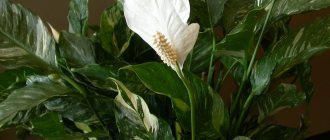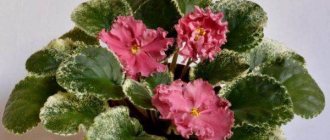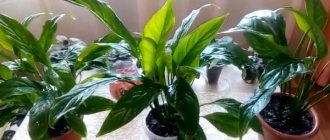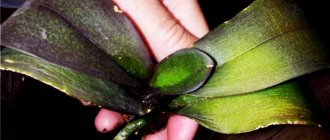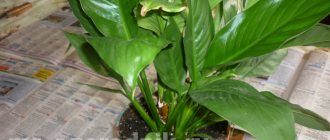To create coziness and harmony in their home, many gardeners place spathiphyllum in their rooms. It not only gives softness to the environment, but is also able to saturate the air with freshness and ensure the purification of oxygen from various impurities.
In addition, the presence of the plant in the house has a beneficial effect on married couples, because it is not for nothing that spathiphyllum is called “Women’s Happiness”. The plant has a number of varieties that do not require significant care and specific care. Among all types, Sweet Chico has distinctive features.
Subvarieties and their photos
Silvio
The variety is characterized by graceful inflorescences and a lush bush.
The flower size is 75 cm. Silvio is characterized by rapid growth. The surface of the leaf plate is smooth, length 30 cm, edges wavy.
Lauretta
The variety was obtained in 2001. The height of the bush is 80 cm, and the width is 85 cm. The leaves are elongated and oval in shape, have light veins, and the inflorescences are directed upward on a high petiole.
Spathiphyllum Benito
The peculiarity of an adult plant is its ability to produce up to 15 inflorescences during the flowering period. The plant is also resistant to external factors: light and excessive watering.
The size of the bush is compact, the leaves are narrow, and their length is 35 cm. Their surface is glossy and smooth.
Spathiphyllum Chico
This variety grows to large and voluminous bushes. Its height is 70-75 cm. The flowers are large, snow-white, and have the shape of a cone. The variety is easy to care for.
If you are interested in this unusual and beautiful flower, then we suggest that you familiarize yourself with other types of spathiphyllum. We will tell you in detail about growing and caring for varieties such as Strauss, Cupido, Wallis, Picasso, Alana, Domino, Sensation, Chopin, as well as varieties with red and white flowers.
Difference from other species
The main difference between spathiphyllum Sweet Chico and other species is its unusual appearance. During flowering, a white blanket appears at the tip of the peduncle, and the sizes of the flower and leaves of this variety are approximately the same.
Make friends with spathiphyllum. The plant will enliven and decorate your home, create a mood, refresh the air and fill the house with joy. And on our Internet portal you will find photos and useful information on growing red flowers, as well as varieties of Alana, Silver Cupido, Picasso, Chopin, Domino, Sensation, Strauss, Wallis.
How to propagate?
There are several ways to propagate spathiphyllum, each of which has its own rules and nuances.
Cuttings
This method is best done in spring or summer.
- First of all, cut off the leaf rosette, which is then placed in water.
- When the roots form, you can plant the plant in the prepared soil.
Dividing the bush
This method of propagation is best done in the spring.
- The spathiphyllum bush needs to be divided into parts, each of which has at least three leaf rosettes.
- They are planted in a new pot at the same depth as in the previous one.
- Before this procedure, the roots must be untangled and washed with water.
Seeds
- For this method, the seeds are planted in a pot with previously prepared soil.
- This pot is covered with film, the soil is sprayed until the first seedlings appear.
- After the first 2-3 leaves appear, the plants need to be planted in separate pots.
What those who want to buy spathiphyllum need to know
Before you make a purchase, you need to carefully examine the chosen plant. And only after making sure that it is completely healthy and meets all the requirements for it can you make a purchase.
You should not immediately replant the spathiphyllum into a new container after purchase. It needs to be placed separately from the plants already in the house for several weeks. This is required to adapt the plant to new growing conditions, as well as to find out whether it has any disease or pest damage.
After this period, the plant is transplanted into a container of suitable size with specially prepared soil. As a rule, all plants purchased in stores or on farms are in shipping soil, which does not contain any nutrients and requires replacement.
Depending on the type, condition of the plant and the region, the price of spathiphyllum ranges from four hundred to six thousand rubles .
Bloom
When and how?
Spathiphyllum, as a rule, begins to bloom at 6-7 months, and its inflorescences last longer than a month. Due to this feature, its flowers are often used for cutting.
Care before and after
- Spathiphyllum prefers a warm and humid climate, so it needs careful care at home.
- For rapid growth, it needs a large amount of light and a variety of feedings. Fertilizers that contain calcium and phosphorus are perfect for this. Preparations containing nitrogen, on the contrary, can harm the plant. Their use should be stopped.
- Spaciphyllum requires moderate watering as the soil dries out. At the same time, complete drying out should not be allowed.
- To prevent the leaves from losing their elasticity after flowering, the dried bud must be cut off. After this, you no longer need to apply fertilizer. The foliage must be sprayed regularly instead of the usual watering.
What to do if it doesn't bloom?
Sometimes it happens that spaciphyllum does not bloom, although all care instructions are followed correctly. There are various possible reasons for this phenomenon.
- A common cause is lack of lighting. If the plant does not receive enough light, it should be placed on the sunny side.
- Sometimes spaciphyllum drops its buds and stops blooming if the ground dries out. This indicates that he does not have enough fluid. In this case, you need to water the flower more often and use soft, filtered water.
- In addition, spaciphyllum will not bloom if planted in a pot that is too small. For normal development, it needs the roots to occupy the entire container. Therefore, you need to carefully choose a pot for the plant.
Spathiphyllum Sweet Chico
I received a flooded Sweet Chico spathiphyllum. Judging by the condition, it is flooded. The leaves are very blackened, it’s time to cut off the entire leaf. Although a small baby is growing from the ground, it is apparently flooded - the tip of the leaf is already black. It sits in a cut-off glass bottle, and, as I can see, it’s filled sooooo much! There, the water inside seems to be flowing back and forth, but there seem to be holes for the water to escape. I carried it in a paper bag down the street, I think it might have been frozen. Please advise where to start? Definitely pull it out, but what next? Should I let it sit on a piece of newspaper to let the roots dry? Tear off the rotten ones if I find them. I also see that the earth needs to be changed - here it is greasy for spatika. Or even take it out and clean the roots from the ground under water and put them in a glass of water for a week? to grow new roots and improve leaves. Tell me more about the variety itself, how capricious and does it bloom well?
Plants for a children's room: spathiphyllum: 4 comments
What a cool flower! As soon as we renovate the nursery, I will put spathiphyllum, hyacinth, and myrtle there, on your advice!
Hyacinth should not be placed in the nursery; it has a very strong smell and can cause headaches. It's better to leave it in the common room and enjoy it during the day.
I bought this flower a year ago. I can only say one thing, it is very unpretentious and pleases with its new shoots, and of course flowers.
I just read on another site that spathiphyllum is poisonous and if a child accidentally swallows a piece of the plant, there may be problems, 10 houseplants that are deadly for health. It is unlikely that there is at least one living space where there are no indoor plants. They decorate homes, fill them with comfort and, as many believe, clean the air of toxic substances, electromagnetic radiation and harmful bacteria. However, scientists have found that some types of decorative flowers can cause significant harm to the health of humans and domestic animals. The choice of indoor plants must be approached very responsibly, especially if there are small children in the house. In nature, there are a lot of household flowers that are dangerous to health, but during tests, doctors identified 10 plants that should be gotten rid of first:
Sansevieria (Mother-in-law's tongue). Although it does an excellent job of purifying the air, it should still be avoided. This plant can cause nausea, excessive salivation and sore throat.
Aloe Vera
Everyone knows the beneficial properties of aloe, but you should remember one very important rule - it should not be used internally. This will lead to intestinal irritation
And if this is not very dangerous for humans, then for animals such experiments can end very sadly.
Spathiphyllum. Causes allergic reactions. Once in the human body, it leads to swelling of the mouth, tongue, and lips. In more severe cases, it can cause death.
Spathiphyllum is a plant with bright, glossy foliage and unusually shaped flowers that will gracefully and elegantly decorate any room. It belongs to the tropical, evergreen representatives of the Araceae family. Some call it the “white sail” for its resemblance to a ship’s sail. Sometimes you can find another name - spathiphyllum Women's Happiness, as it is believed that it will be the best gift for a woman.
Unpretentious plants
Spathiphyllum Strauss grows up to 30 cm. It has elongated leaves and snow-white flowers. It blooms 2 times a year, usually from spring to summer. It will feel great both in a bright place and in partial shade.
Cupido (Spathiphyllum Cupido) was bred by Dutch breeders at the end of the last century. Quite large (50 cm), attractive and variegated flower. Typically, 8 to 10 inflorescences can be seen during flowering. It blooms already in April and fades in the summer.
Domino (Spathiphyllum Domino) is loved by many gardeners due to its spectacular appearance. Its neat, pointed, narrow leaves have beautiful light streaks.
Domino itself is not tall - 35 cm. This means that it can be placed anywhere. And if the owners fully provide the flower with the necessary darkness, abundant watering and the absence of destructive drafts, it will delight them with its magnificent aroma in the morning.
Spathiphyllum Mauna Loa. The plant is beautiful, has a wide snow-white bract, as well as an elegant cream-colored ear. The leaves are pointed. It blooms for a long time and almost constantly. Usually the inflorescences are cut off in order to preserve their freshness until the end of the month. Originally from Colombia.
What depends on the type?
When growing spathiphyllum, you need to know what species it belongs to. After all, the conditions of detention depend on this. Spathiphyllums are unpretentious, but some species are quite capricious. For example, when the earthen clod dries out, spathiphyllum cannofolia will simply shed all its leaf mass. But mini spathiphyllum will respond to waterlogging of the soil by rotting its roots.
All spathiphyllums do not tolerate direct sunlight, drafts, and do not like large temperature changes - which is why they are not transferred to balconies in the summer. Most spathiphyllums require high air humidity and regular spraying. You also need to take into account the size of the species.
Giant spathiphyllums will be more appropriate in a spacious room; dwarf species will fit perfectly on an indoor window sill.
Big and strong
Only the cannoleaf (Spathiphyllum Cannifolium) plant species can boast such dense leaves, which reach 40 cm in length. The visible side of the bract is white, but the invisible side is green. The inflorescences emit a rather pleasant aroma.
Spoon-shaped spathiphyllum (Spathiphyllum Cochlearispathum) can most often be found in Brazil. Usually grows up to a meter in length. The leaves are thin, shiny, elliptical in shape. The width of one such leaf is 12-15 cm, and the length is 30-40 cm. The petioles sometimes grow up to 70 cm. The shape of the bedspread resembles a spoon, which is why this plant was so named.
Spathiphyllum Floribundum has fairly dense leaves. A fairly noticeable vein is visible in the center of each leaf. Leaf length - 20 cm.
The petiole is thin, its length is usually 10 cm. Compared with other varieties, the perianth is small, its length varies from 4 to 8 cm, and its width up to 3 cm. It pleases with its flowering almost all year round.
An online magazine for parents about the education, upbringing and development of children.
Today we’ll talk about an extremely rewarding plant for a child’s room – spathiphyllum. Why grateful? If you place the spathiphyllum in moderate shade and take at least a little care of it (regularly water and feed it once every two weeks from spring to autumn), then the flower will reciprocate your feelings, blooming very often and profusely with beautiful white flowers that look like sails . It is precisely for the resemblance of spathiphyllum flowers to sails that people often call it a sailboat. By the way, spathiphyllum has another popular name - women's happiness. They say that if you receive spathiphyllum as a gift, then female happiness will not keep you waiting.
How is spathiphyllum useful for a children's room?
Firstly, it is very beautiful and will delight the child’s eye. As we have already said, spathiphyllum blooms for a long time, from spring to mid-summer, and often blooms again in the fall. A good decoration for a child's room, isn't it?
Secondly, the leaves of spathiphyllum are quite voluminous, and the total leaf mass of the plant is large, which is favorable for saturating the children's room with ozone. It will be easier for the child to breathe where spathiphyllum grows.
Thirdly, it is generally accepted that spathiphyllum has strong energy, helps to concentrate and increases performance. It is difficult to prove or disprove this, but you can try by placing spitiphyllum near the student’s workplace.
Spathiphyllum is not poisonous and is not an allergen.
It is better to plant spathiphyllum in the spring, taking a small bush from someone. And you can buy it at any time of the year. If you hurry now, then in the spring the spathiphyllum will delight you and your child with the first flowering in a new place.
Please note that the plant grows quickly and very soon from a small bush you will get an excellent plant - a source of positive emotions and ozone! This is a spathiphyllum that is a useful plant for a child’s room.
Spathiphyllum or “female happiness”: types, photos and signs
Spathiphyllum is an evergreen perennial classified as an araceae and is prized for its showy inflorescences and varied foliage hues. The homeland of spathiphyllum is considered to be South America, East Asia and Polynesia.
This is a very moisture-loving plant, so it grows mainly in swamps, wet forests, and also on river banks. Most spathiphyllums are terrestrial plants, but epiphytic species are sometimes found.
The plant is stemless; tufts of its long foliage are located on small petioles that grow directly from the ground. The inflorescence consists of a spadix and a white spathe surrounding it, which turns green towards the end of flowering.
Because of its similarity to a sail, the plant is called white sail in everyday life . With proper maintenance, depending on the type, flowering of spathiphyllum can continue from early spring to early autumn or in the spring-summer and autumn-winter periods with a short break (almost all year round).
Spathiphyllum is popularly known as “women’s happiness” or “women’s flower,” which is why it is so loved by women and especially young girls. But we'll talk about this later.
When working with a plant, you need to know that spathiphyllum is poisonous . Its juice contains a large amount of calcium oxalates, which lead to a burning sensation in the mouth and respiratory tract, increase salivation, and cause inflammation of the gastrointestinal tract and mucous membrane of the eyes. To avoid trouble, you should use gloves and wash your hands thoroughly.
Reproduction
The plant reproduces in 3 ways:
- Dividing the bush. It is better to transplant in the spring. The separated part of the plant must have at least 3 strong leaf rosettes and a fragment of a healthy rhizome. Before dividing, the root should be well saturated with water, washed, and untangled.
- Seeds. With this propagation method, the plant will bloom only after 3 years. The advantages of this method include the fact that spathiphyllum grows more hardy and strong, less demanding on air humidity.
- Cuttings. It is carried out in the warm season. Cut off the leaf rosette and add water to it until the root appears. Then they are transplanted into a pot of a suitable size and covered with film.
Transfer
Spathiphyllum will need to be replanted only if the flower becomes cramped in the pot - stopping flowering will indicate this.
When removing a flower from an old pot, there is no need to clean the roots from the soil - excess contact can harm the thin sensitive shoots. It is replanted using the transshipment method - together with the old soil, only adding a little new soil on top.
The soil for spathiphyllum consists of equal parts of leaf and turf soil, peat, river sand and humus. When purchasing soil in a store, it is recommended to take a ready-made substrate for aroids.
Spathiphyllum transplantation is carried out in the spring.
Popular varieties of spathiphyllum
Active breeding work to develop new varieties of “flower-sail” began in the second half of the last century. Although they knew about it back in the 19th century, when the German scientist Gustav Wallis gave its botanical description, thereby introducing the world to a beautiful plant. Today there are about 45 types of flowers. They all have one or another distinctive feature; they can be huge in size, but there are also tiny varieties. For propagation at home, only certain types of spathiphyllum are used - they are the ones that have become the most popular among flower growers. You can see the article: Azalea: the best varieties of culture.
Spathiphyllum Wallis - the ancestor of many varieties
Named after the German botanist who first discovered this species, Spathiphyllum Wallis gave rise to many famous varieties and varieties of the flower.
All of them have earned the love of flower growers around the world for the combination of two wonderful qualities: exotic appearance and simplicity of maintenance. All varieties included in this species are small in size. Their average height does not exceed 30-40 cm. Corn-shaped inflorescences, 3-4 cm long, are surrounded by a white, sail-shaped petal, the color of which gradually turns green towards the end of flowering. The same thing happens with the arrow flower. Initially it is creamy, but then turns green along with the petal.
Chopin variety – beautiful music of nature
Spathiphyllum Chopin or Chopin is especially famous. The scientific name sounds like Spathiphyllum Chopin. The variety has become widespread, first of all, for its beauty. But ease of care also played a decisive role: Chopin spathiphyllum is not so difficult to grow at home.
Features of foliage
One of the advantages is the compactness of its bush - 35-40 cm. This allows it to be kept in rooms with different dimensions. Its appearance is classic for this culture. The elongated oval leaves are pointed at the ends. Their veins are clearly and symmetrically drawn across the entire sheet. The stripes on the leaves are deeply pressed, which creates a beautiful relief on the surface and makes the plant more decorative. Healthy foliage is rich, green, shiny, as if polished.
Flowers are the main decoration
I fell in love with this variety for the beauty of its flowers. They are bright, white, with a slight greenish tint. The sail is elongated, pointed, with veins, also painted in a delicate white-green color. It is valued for its ability to emit a pleasant, not pungent aroma in the afternoon. In order for spathiphyllum to bloom, proper care is necessary.
Variety Domino - a play of colors
Spathiphyllum Domino has a rare color for this indoor plant - its variegated, dark green, white-speckled foliage will enliven any office or living space. Despite the fact that this flower is very exclusive, it is completely unpretentious and easy to care for, so it is suitable even for beginners in floriculture. Its compactness also speaks in favor of its purchase - the bush does not grow higher than 35 cm. In the morning, graceful, white flowers with soft green veins will saturate the air with a subtle aroma, which gradually disappears by midday.
Properties of spathiphyllum and signs associated with it
There is a popular legend: if you give someone a spathiphyllum indoor plant, then family happiness will go with it. And in order for there to be prosperity in the house, you need to carefully and painstakingly care for the plant so that it is always healthy and blooms profusely.
Since spathiphyllum is considered a female flower, you will not have problems with a gift for a woman whose personal life is not entirely well-settled. After all, it is the gift of a flower that will help:
- Single women find their only man and start a family;
- A childless woman can finally find the happiness of long-awaited motherhood;
- A married woman who is unhappy next to her companion can improve family relationships, restore harmony and understanding in the home.
In order to strengthen or renew faded feelings and harmonious relationships of a married couple, you need to place anthurium next to the spathiphyllum, which symbolizes the masculine principle. The innocence of spathiphyllum and the passion of anthurium are in this case an ideal tandem. In addition, both plants are aroids; by placing spathiphyllum and anthurium together, you can make caring for them easier.
If we talk about scientifically proven facts, it can be noted that spathiphyllums absorb a number of harmful substances that enter our homes from the atmosphere and, for example, from finishing materials (benzene, phenol, formaldehyde, acetone and others). In addition, they release oxygen much more actively than other indoor plants at night. Its high phytoncidal properties kill pathogenic bacteria. By purifying and healing the air in the bedroom, spathiphyllum promotes healthy sleep.
Spathiphyllum is capable of killing a number of microorganisms, and thanks to this, it can help rid the house of mold. In addition, it helps people recover quickly in case of prolonged stressful situations and emotional exhaustion.
In addition, it helps improve mental and physical performance . Some scientists even believe that the human biofields and this spectacular plant have much in common.
Spathiphyllum is a universal plant suitable for almost any corner of your home. The variety of sizes and shades of foliage provide a wide field of activity for decorating the interior with their help, and elegant flowers, reminiscent of calla lilies in shape, inspire creativity even in those people who are very far from this field of activity.
And from this article you can learn how to propagate anthurium at home.
Why anthurium leaves turn yellow and how to deal with it is described here.
Perhaps from the video describing spathiphyllum you will learn something that was not found in the article:
Beautiful examples
In residential premises, culture acts as a decorative item. Plants are planted in snow-white pots of various geometric shapes, emphasizing the color of the bracts and highlighting the rich tone of the foliage.
Flowers can be planted in groups in wide planting containers. This method is used to visually divide space into zones in residential and office premises, as a decoration for various massive interior items: dining tables, chests of drawers, and so on.
In landscape design, spathiphyllums act as a border or flower arrangement. They require high-quality soil drainage, its composition and care as the plant grows.
An overview of the types of spathiphyllum is presented in the following video.
Spathiphyllum is a stemless perennial from the tropics. Most flowers similar to spathiphyllum belong to the araceae family. This group includes decorative foliage and beautiful flowering plants.
Spathiphyllum red
Most nurseries grow spathiphyllums with red or pink bracts. What is this rare variety of a well-known flower? These are anthuriums - close relatives of our plant, belonging to the aroid family. Originally from South America.
The leaves of this plant are dark, usually resembling a heart shape, but they do not grow from the ground, they have a stem. It is thanks to selection that they delight gardeners with their bright shades.
Anthurium, although beautiful, is too pretentious. Dry air is unacceptable for it; watering must be timely. If the conditions are not met, the handsome man will simply wither away.
Thanks to the tireless work of breeders, new varieties of this wonderful tropical flower appear year after year. They are so impressive and beautiful that sometimes it’s even difficult to make a choice in favor of one.
Diseases and pests
- Spathiphyllum diseases most often affect the leaves of the plant. One of the most common problems when growing is yellowed leaves. This happens if the plant is rarely watered.
- If spathiphyllum does not have enough moisture, the leaves dry out and curl. If the lighting is too bright or the plants are exposed to direct sunlight, the leaves may become pale and fall off. If the foliage, on the contrary, turns black, the reason is most likely a disease of the entire root system. This can happen when there is an excess of water and fertilizer.
- A dangerous pest for spathiphyllum is the spider mite. It envelops the inside of the leaf with its web, which leads to its drying out. In order to get rid of the pest, you need to use an onion or soap solution, which is used to clean the leaves from cobwebs.
- Aphids may appear from the bottom of the foliage, sucking the juice from the plant and multiplying very quickly. They get rid of it with the help of nicotine sulfate. But this solution should have a low concentration.
- If the leaves become covered with dark spots, the cause may be scale insects, a common pest. You can fight it with a soap solution to which tobacco or kerosene is added.
Spathiphyllum Sweet Chico is an ideal indoor plant that will help create coziness and a pleasant atmosphere. If you follow all the rules for caring for the plant, it will become a real decoration of your home.
If you find an error, please select a piece of text and press Ctrl+Enter.
https://stroy-podskazka.ru/spatifillum/sorta/vidy/https://pocvetam.ru/komnatnye-rasteniya/dekorativno-listvennye/spatifillum-svit-chiko.htmlhttps://selo.guru/rastenievodstvo/derorativ/ spatifillum/vidy-sp/svit-chiko.html
Choosing soil and container for a flower
To root a young plant, it is necessary to prepare the soil substrate. To do this, it is necessary to combine dry crushed peat, leaf humus, manure humus and river sand in equal parts. Additionally, broken fragments from ceramic flowerpots or tiles are introduced into the substrate, and specially crushed birch charcoal is added.
If it is not possible to prepare the substrate yourself, you can purchase it at a specialized store for Aroid plants. The container for planting should be small in size - up to 10-15 cm in diameter. In the future, the plant should be replanted annually over the next 5 years.
Planting work is carried out in the spring - in the last days of February or the first week of March.
Broken shards are placed at the bottom of the selected container so that most of it falls on the drainage holes, protecting it from soil spillage. The soil substrate is poured from above to the middle of the flowerpot.
A seedling is installed in the central part and filled with nutritious soil so that there are no gaps left in the roots. In empty cavities, water can stagnate after watering and provoke the formation of fungal diseases or root rot. After planting, the soil near the seedling is compacted and well watered. In the future, standard plant care is carried out.
Diseases and pests
Most often, diseases affect the leaf blade, resulting in the following problems:
- Yellowness of leaves. It occurs when watering is infrequent and the humidity in the room is too low.
- Drying and curling of leaf tips. This problem occurs when there is insufficient humidity and cold air.
- Pale leaves. The reason is that the lighting is too bright.
- Leaves may turn black if the root system is diseased. And this happens as a result of excess moisture. Also, blackness on the leaf plate is the result of unbalanced fertilizing.
Dangerous pests include:
- Spider mite. It is located on the inside of the leaves, enveloping it in a cobweb. After a while, the leaf plate dries out. To combat, use a soap solution, only first clean the leaves from cobwebs. Onion solution (100 g of peel and 5 liters of water) is also effective.
- Aphid. It settles at the bottom of the leaf blade. This insect is characterized by rapid reproduction. It feeds on the sap of the plant, causing the leaves to curl. To combat, use a solution of nicotine sulfate (1 g per 1 liter of water).
- Shield. It covers the leaf blade with dark spots. For processing, a soap solution with the addition of kerosene and tobacco is used.
Spathiphyllum variety Sweet: features
This spathiphyllum hybrid grows up to 70-75 centimeters in indoor conditions.
- The flowering period of the plant begins in late spring.
- Spathiphyllum blooms profusely in late autumn, provided that the required level of humidity in the room is maintained.
- The plant does not tolerate sudden changes in temperature and strong drafts.
- For good growth and development of the flower, the temperature is maintained between +22 and +30 degrees.
Many varieties of spathiphyllum , for example, Sweet Silvio , Sweet Chico, during flowering change the color of the peduncle to greenish.
Video
Name: Spathiphyllum Sweet Chico
Homeland: South America, Malaysia
The genus Spathiphyllum unites more than 30 tropical plant species originating from South America and Malaysia.
All hybrids grown as houseplants are derived from Spathiphyllum wallisii, native to Colombia. This is a low plant with paddle-shaped glossy bright green leaves about 30 cm long, with wavy edges and pronounced veins. Small and round true flowers of creamy white color are collected in an inflorescence (small spadix) wrapped in a white bract (spread). As they ripen, both the cob and the spathe acquire a green color. Spathiphyllum flowers are very stable and bloom for a long time. Many decorative varieties and varieties have been developed, both small ones, for example “Small”, which is widely used in compositions, and very large ones, for example “Mauna Loa” and “Giant”. Other popular varieties include Bold, Feeling, Adagio, Prelude and Palace.
GROWING
Spathiphyllum Wallis is cultivated only as a houseplant. When growing, mineral fertilizers must be used. In spring and summer from the end of March to the end of September, once every 10 days, when watering highly developed specimens, diluted liquid fertilizer is added to the water (to feed weak plants, fertilizer is taken in a lower concentration). During the rest of the year, regardless of size, plants are fed once a month. Spathiphyllum is ideal for hydroponics.
LIGHTING AND SITE SELECTION
Spathiphyllum prefers a well-lit place, especially in winter. In summer, you need to make sure that direct sunlight does not fall on them, which causes burns to the leaves. Partial shade is best for them.
TEMPERATURE
Winter temperatures should not be high: optimally - about 16 ° C - then a dormant period begins, which promotes flowering in summer. The plant can tolerate temperatures not lower than 12-13 ° C. In the summer months, spathiphyllum feels comfortable at a temperature of 25-27 °C. Does not like sudden temperature changes and drafts.
WATERING AND FERTILIZER
It is necessary to constantly maintain moderate, or possibly high, humidity. This requires abundant watering (there must be good drainage) and frequent spraying of the above-ground parts with water. To establish the optimal humidity level, you can also place the pot in a tray with expanded clay. In winter, water less often.
APPEARANCE CARE
The leaves are cleaned with a damp cloth (the use of lustrating solutions is not recommended). Withered leaves and inflorescences (the spadix enclosed in a spathe) should be removed by cutting them off at the junction with the stem.
TRANSFER
If it is clear that the roots of the plant have filled the entire volume of the pot, then begin replanting. This operation is carried out in the spring, or even annually, using ordinary universal humus, which is used to fill a pot 1-2 sizes larger than the previous one.
REPRODUCTION
The easiest way to propagate spathiphyllum is by dividing the bush in the spring. The roots are also carefully separated. Plants obtained as a result of division should be planted in pots or cups filled with loose peat soil with a pH of 5.5-6, with a good drainage layer on the bottom; the temperature is maintained at about 20 °C.
DISEASES AND PESTS
Spathiphyllums are usually quite resilient plants. When attacked by mites, small yellowish specks appear on the leaves; get rid of them by treating them with acaricides, and also by maintaining high humidity. Scale insects hiding in the most sheltered places provoke gradual withering and death of the plant. This pest is eliminated by treating with a cotton swab dipped in alcohol, after which the plant is sprayed with an anticoccidal drug. If aphids appear on young shoots, this leads to deformation and curling of the leaves into tubes. Appropriate processing required.
Everything you need to know about transplantation
Plants obtained from the mother bush should be replanted annually until adulthood. In adulthood, frequent handling sometimes injures the plant. Therefore, experienced gardeners advise simply replacing the top layer of soil with fresh soil substrate and applying organic fertilizers more often.
The transplantation event should be carried out in early spring. This is a favorable time when the plant begins to wake up from short-term hibernation and gain strength for a new flowering period.
To replant, you will need a flowerpot only a few cm larger than the previous one - 2-3 cm.
An excessively large pot will stimulate the development of the root system, which will inhibit the growth of the above-ground part and delay the flowering period. After the selected pot, fresh soil is prepared, which is poured onto the drainage previously placed at the bottom of the container. The flower is carefully taken out from its usual place. There is no need to shake off the soil from the rhizomes. This can damage the root system and stop the growth of Spathiphyllum Sweet Chico for a long time. This method of transplantation is called transshipment.
From above, before rooting into a new flowerpot, you need to carefully examine the rhizomes for the presence of diseases or rot. If damaged parts are found, remove them and sprinkle them with ash or activated carbon. The next step is to place the plant in the center of the flowerpot and fill the sides with fresh soil. Then compact the soil and water thoroughly. After the event, you should not water for 2-3 days, just spray.
“The Scarlet Flower” - fact or fiction
Sometimes flower growers try to find red spathiphyllum on the shelves, confusing it with another representative of the Araceae family - anthurium.
The fact is that all representatives of spathiphyllums are characterized by a white petal-sail, sometimes with greenish veins or inclusions. After flowering they can turn bright green, but they can only be made red using coloring chemistry. Anthurium is indeed very similar in appearance and in many botanical characteristics to spathiphyllum. It is its funnel-shaped petals that envelop the cob that lead to confusion. They come in red, burgundy, pink, purple, orange, and sometimes multi-colored. Unlike spathiphyllum, which is considered the flower of female happiness and family well-being, anthurium symbolizes masculinity and strength. They are often kept together as their care is largely the same. In addition, it is believed that such cohabitation of flowers leads to harmony in the family.
Mini crop varieties
During selection, a tiny variety was bred, the so-called spathiphyllum mini or dwarf, its height does not exceed 15 cm.
An example of compact flowers is also the Strauss spathiphyllum, the foliage of which does not grow above 30 cm. Its leaves are dark green, elongated, dense, reminiscent of well-dressed leather, with a glossy coating. The flowers are creamy white with a snow-white sail.
The same varieties with miniature volumes of foliage and small flowers include: Macho, Mozart, Quattro. All of them were obtained from Spathiphyllum Wallis, and therefore have similar characteristics.
Varieties of giant spathiphyllum
In contrast to miniature varieties, Dutch scientists created Spathiphyllum Sensation, distinguished by large and powerful foliage and flowers.
During its breeding, the goal was to obtain a large-sized office plant that would not be afraid of poorly lit, large rooms. It can reach a height of 1-1.5 m. Its leaves are dark green, oval-pointed, burdock, large, their length can vary between 40-80 cm. The foliage is very prominent due to the recessed longitudinal stripe and diverging to the sides veins No less beautiful are the large flowers - the cobs, wrapped in a white petal cover.
No matter how outlandish the giant flower looks, caring for the giant spathiphyllum does not cause any particular difficulties. When creating a hybrid, Dutch scientists also took care of the simplicity of its maintenance.
Variety Sweet Chico
Varieties distinguished by large, voluminous bushes include spathiphyllum Sweet Chico, descended from the Wallis species. Its average height is 70-75 cm. It blooms with large, snow-white flowers in the shape of a cone twice a year. Just like other varieties, it grows without stems, with leaves growing directly from the ground to form a lush bush. It is characterized by simplicity of content.
Variety Cupido
Spathiphyllum Cupido differs from all other varieties by its high “leg” - an elongated petiole on which shiny, bright, green, embossed leaves are formed. They are elongated and elongated, and on their plane there is an embossed pattern of veins. The flowers are bright white, devoid of any shades, cone-shaped, with pointed ends. The total height of the plant is 50 cm.
Alana variety
Spathiphyllum Alana is also characterized by leaves with elongated cuttings. Thanks to this feature, the foliage does not bend down, as happens with most varieties of the plant. The foliage constantly maintains a vertical position, which significantly improves the decorative properties of the flower. Outwardly, it is very similar to the Cupido variety. The only difference is that on the back of the white petal there is a longitudinal green stripe. In order for caring for Spathiphyllum Alana at home to be successful, you must comply with several simple requirements, which will be discussed below.
Subsorts with photos
Next, you can learn about the varietal forms Chico, Silvio, Lauretta and Benito, and also see them in the photo.
Silvio
Silvio is a very beautiful variety of spathiphyllum with graceful flowers up to 75 cm in size. Characteristic features are lush foliage and inflorescences, fast growth. It has smooth leaves up to 30 cm long with wavy edges.
Lauretta
A relatively young variety of spathiphyllum, which was bred in 2001. Its leaves have an elongated oval shape with light veins. The bushes of the plant reach a height of 80 cm and grow up to 85 cm in width. They have a high petiole with inflorescences directed upward.
Benito
A compact variety of spathiphyllum with narrow, glossy leaves and up to 35 cm in length. However, this plant can grow up to 15 inflorescences during flowering. It is resistant to climate change and different types of lighting.
Chico
The easiest variety of spathiphyllum to care for and grow. It is large in size. The height reaches 70-75 cm. It is distinguished by large snow-white flowers in the shape of a cone (read about popular varieties and features of growing white spathiphyllum here).
Spathiphyllum
09/13/2014 admin 1
Spathiphyllum
Family
- aroid.
Origin
— Philippines, Central, South America.
Love of light and high humidity are the hallmarks of spathiphyllums. In nature, their favorite places to grow are tropical forests. Mainly distributed in river valleys and along sea coasts. In nature, there are about 40 species of spathiphyllum; the home “assortment” is much more modest.
This herbaceous plant has a short stem that ends in a rosette of long oval green leaves with an elongated tip. Leaf length - up to 50 cm. Flowers - white or yellowish, externally small and inconspicuous
, collected in an inflorescence in the form of a cob. But this ear is covered with a spathe (white or yellow-green), and overall the plant looks very nice. The flowering period is quite long; the plant blooms once or twice a year.
Considering that spathiphyllum at home is extremely unpretentious and does not require care, even those who believe that “house flowers do not grow” can cope with its cultivation.
Thanks to its strict and at the same time elegant appearance, the spathiphyllum flower is widely used as an office plant. It can often be found in public places - shops, beauty salons, etc. Belongs to the same family as Alocasia.
Spathiphyllum is popularly known as “women’s happiness”, “flower of happiness”, “men’s happiness”, “flower of love”. According to signs, this flower really has miraculous powers.
It’s better not to decide, but to get this wonderful green pet. Let his magic be unnoticed!
Features of a houseplant
Spathiphyllum Sweet Chico is a hybrid shrub plant that lacks a stem. The bush is perennial and belongs to the Aroid family tree. The first appearance of the original exotic was recorded in the Philippines, as well as in America - South and Central.
The flower actively grows in nature on swampy shores and in tropical rainforests. Therefore, when maintaining a bush at home, it is recommended to try to create maximum conditions for its cultivation.
Spathiphyllum Sweet Chico was obtained thanks to the work of breeders from the Wallis variety. Sweet Chico's height can reach from 70 cm to 80 cm. It is a fairly large variety:
- The deciduous blades of the Sweet Chico shrub grow directly from the root system. They are located on long, erect petioles. The foliage has a lanceolate-oval shape, a glossy coating, which is lined with straight stripes of veins. The foliage has a rich green tint.
- Arrows also appear from the soil substrate. During the flowering period, enough of them grow that the flower transforms and becomes like an original fan with bright candle lights.
- The inflorescence spadix is white or white-green, surrounded by an outer petal called the spathe. As the flowers fade, the outer petal gradually changes its color, changing its tone to greenish.
Under favorable conditions, flowering can begin in early spring and end only by the end of the last autumn month. In most cases, the shrub tends to interrupt the budding period and, after a short rest period, begin to produce white inflorescences again. So the plant can bloom from April to August, then rest until November and again delight with the original color of the white swallowtail.
Care instructions
Selecting a location
Spaciphyllum Sweet Chico needs a lot of light and warmth, so it is better to place this plant on the east, north or west side. The flower should not be exposed to direct sunlight.
What should the soil be like?
Spaciphyllum takes root best in loose soil with a neutral pH. To create ideal soil, you need to mix humus, peat, sand and turf soil in equal proportions.
Landing
It is best to plant spaciphyllum in late winter - early spring.
- First of all, drainage is placed at the bottom of the selected pot, and then pre-prepared soil is poured.
- The seeds need to be scattered evenly over the surface of the soil, slightly deeper into the ground. Then the soil is sprayed with clean water using a spray bottle and covered with polyethylene. This covering must be removed every day for a while to give the plant a chance to ventilate.
- When the first shoots form (usually this happens after 10 days), the film can be removed and the pot placed in a well-lit place. After the first leaves appear, you need to pick.
Temperature
In summer, the optimal temperature for spathiphyllum is 22-24 degrees. In winter, the minimum permissible temperature is 16-17 degrees. At temperatures below 13 degrees, flower growth slows down, this negatively affects the condition of the plant as a whole.
Watering
For spathiphyllum, abundant watering is important, which should be done 2-3 times a week. For this purpose, use only distilled water.
It needs to be poured into the pot very carefully so that it only gets on the ground.
Spathiphyllum leaves should be sprayed with a spray bottle to prevent them from drying out. This procedure is carried out about twice a week. In winter, this can be done less often.
Top dressing
The most suitable time for applying fertilizers is from March to September. To do this, you need to use complex mineral compositions. In order not to harm the plant, the solution should have a weak concentration - no more than 1 g per liter of water. The flower must be watered well before and after fertilizing.
It is not recommended to use fertilizers more than once every two weeks. To make flowering last longer, you need to use fertilizers that include phosphorus and potassium.
Trimming
When flowering is completed, the peduncle must be cut off so that it does not absorb nutrients. You need to cut it as close to the rhizome as possible. If there are dried and diseased leaves, they also need to be cut off and the cut areas treated with charcoal.
Transfer
When the rhizome has spread to the entire pot, you need to replant the plant. The transshipment method is ideal for this.
- It is necessary to remove only a small part of the soil from the root system so as not to damage them.
- Rotten rhizomes must be cleaned.
- To replant the plant, use a pot larger than the previous one to give the roots room for further growth.
- After this, watering must be reduced, and the pot must be covered with film again and ventilated a couple of times a day.
Growing conditions
In order for the plant to develop well and quickly, it is necessary to follow certain care rules. It is recommended to choose the optimal location. Lighting and temperature conditions that allow you to recreate favorable conditions for growing.
The following tips for caring for spathiphyllum Sweet Chico are highlighted:
- Location - in summer the plant actively develops and blooms well if installed on a north window. On winter days, when there is a lack of sunlight, the flower must be placed on a south window. This is due to the fact that usually all plants are hibernating in winter, but spathiphyllum continues to bloom. If it is not possible to install on these sides, then the plant tolerates being in other places well, but it must be taken into account that the volume or, conversely, lack of sunlight can lead to burns or other diseases. It is better if such a place of residence is selected - semi-dark, but at the same time providing access to the rays of the sun in the morning. If you place a flowerpot with a flower in a dark room, its foliage will acquire a dark tone and stretch out, while being crushed, and when placed on the sunny sides, the leaf plates will lose all their color, becoming pale.
- Temperature regime - in the summer it is recommended to keep the room at +22..+26 C. In winter, you should not reduce the temperature to a minimum of +16 C. If the degrees in the room drop to a critical +13 C, then the flower slows down its growth and goes into hibernation, losing their rich shade, and the buds dry out and fall off.
- Humidity – the plant belongs to moisture-loving shrubs that love humidity more than drought. Therefore, the bush should be periodically sprayed or given a contrast shower. In winter, you should not place the flowerpot on window sills with heating devices. If there is no other possibility, then you need to spray the green plates once a day. Otherwise, the bush may quickly dry out and die.
Following the simple rules necessary for growing will allow you to get a healthy, spreading plant - a chic spathiphyllum Sweet Chico. Otherwise, if you do not adhere to certain rules, the bush will quickly die.
Reproduction methods
Propagation of spathiphyllum by cuttings
To root spathiphyllum cuttings, it is recommended to use moistened sand. They need warmth (not lower than 22 degrees). After the cuttings grow roots, they are planted in individual pots filled with a soil mixture consisting of leaf, peat and turf soil, as well as sand (2:2:1:1).
Reproduction of spathiphyllum by division
During transplantation in spring, if desired, the flower is propagated by dividing the root. Young growth points are formed at the shortened stem, and new leaf blades appear from them. If necessary, divide the root into several parts, with each division containing 2 or 3 leaf blades and one growing point. The division is carried out in a warm place (about 21 degrees). To plant the cuttings, use pots up to 15 centimeters in diameter, as well as a soil mixture consisting of peat, sand, humus and leaf soil (2:1:2:2), and you also need to add some pieces of brick, charcoal and bark to it . You can also use a substrate of coniferous and leaf soil, peat, sand and humus (2: 2: 2: 1: 2). A mixture of leaf, peat, coniferous and humus soil, as well as sand (2: 4: 1: 1: 1) is also suitable. It is recommended to add a small amount of charcoal to it.
SPATHIPHYLLUM REPRODUCTION. DIVISION OF THE BUSH. I waited!)
